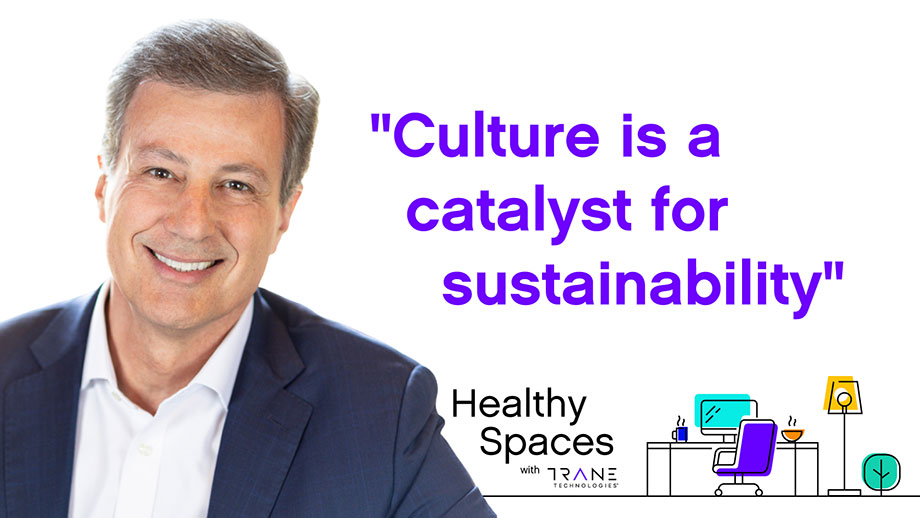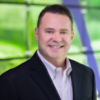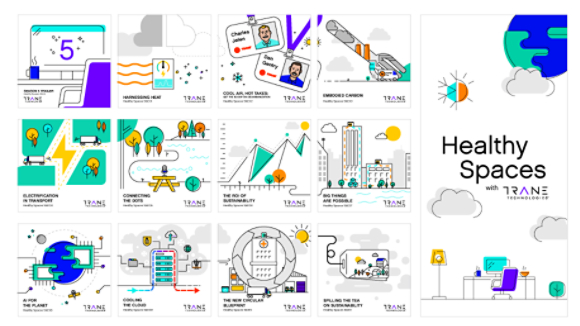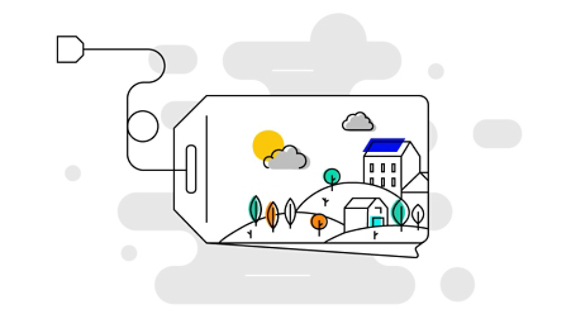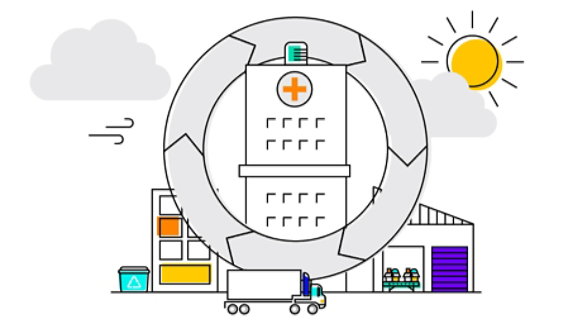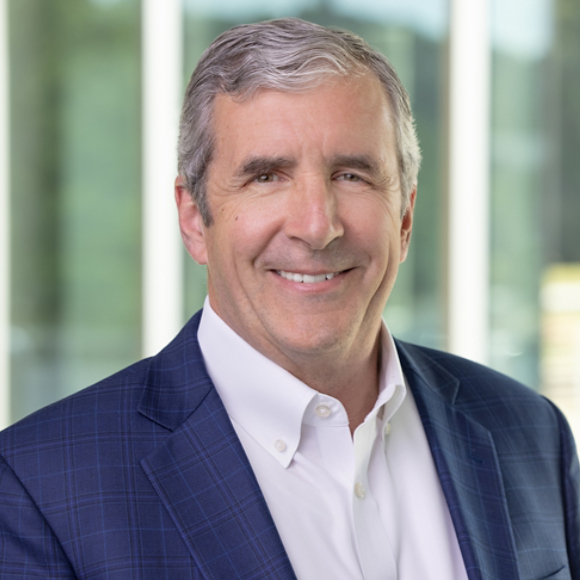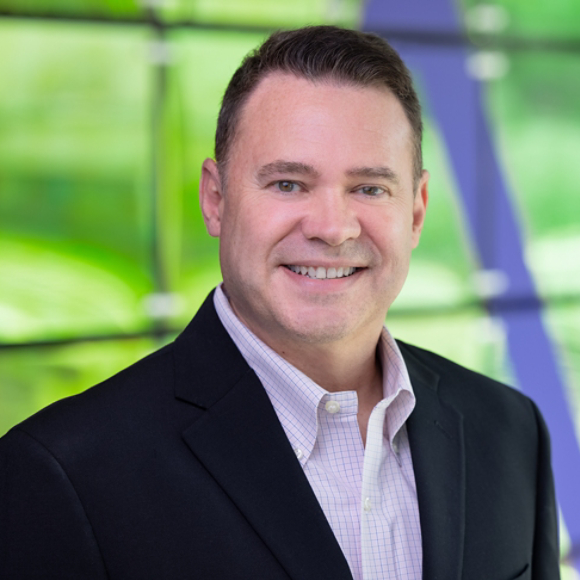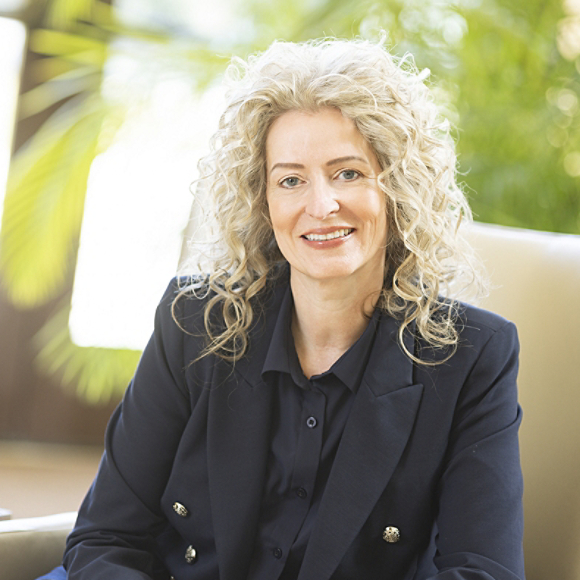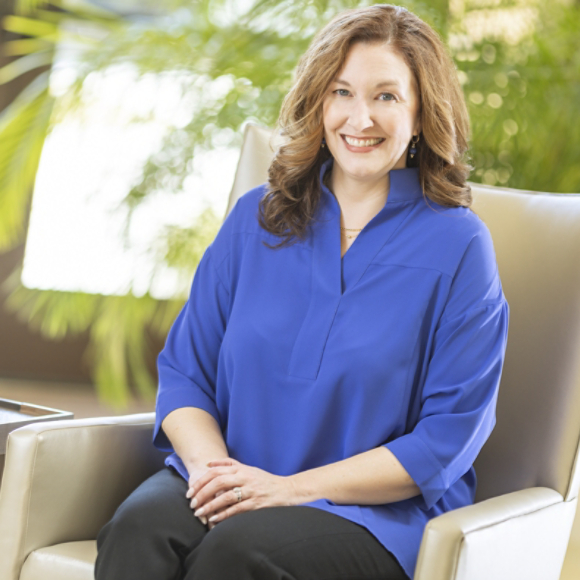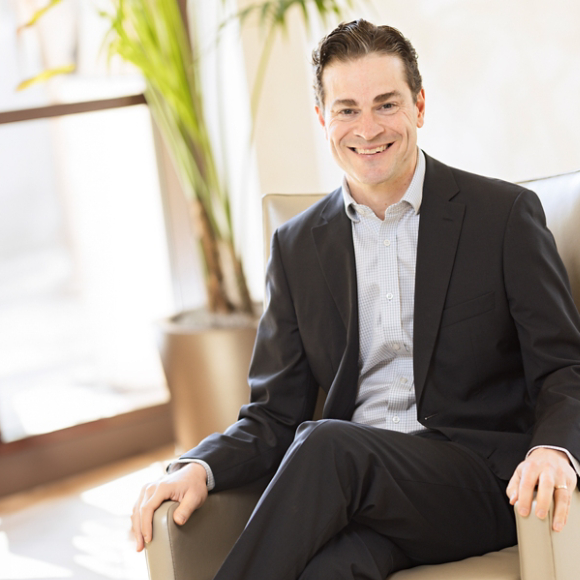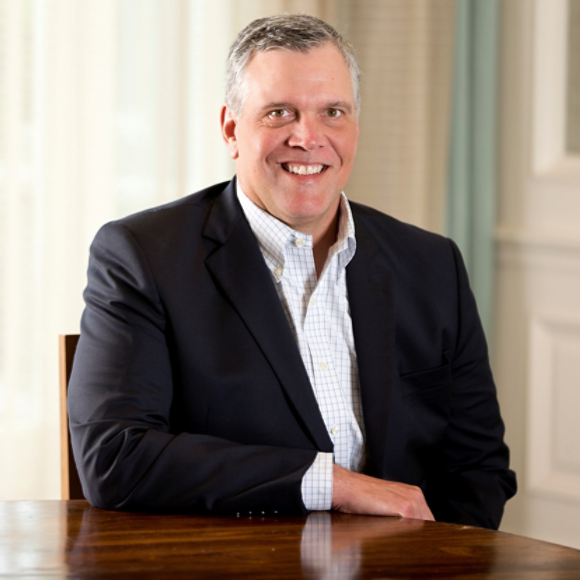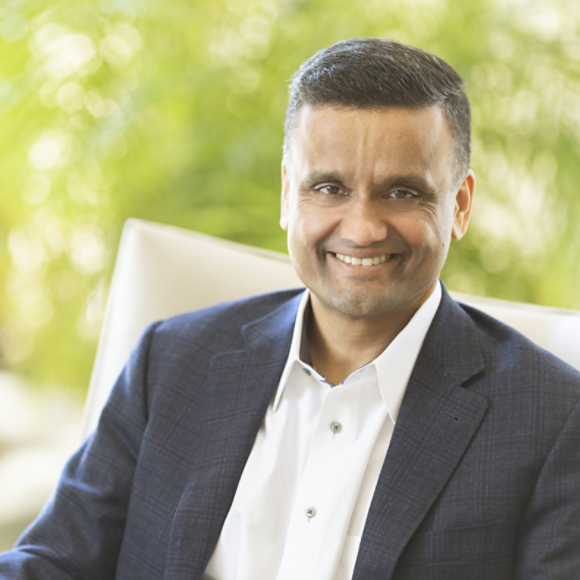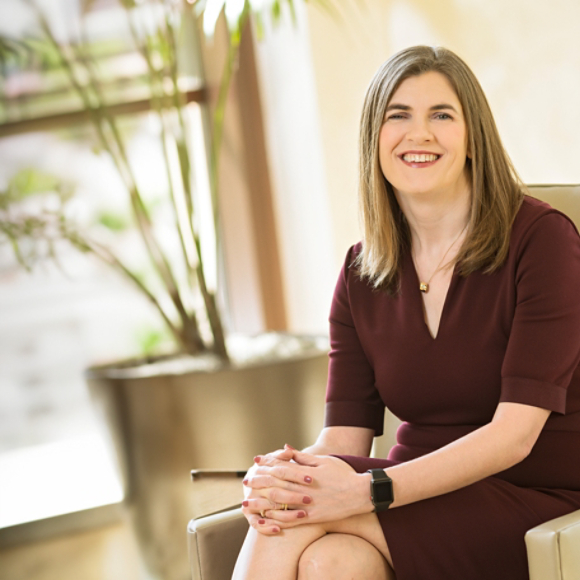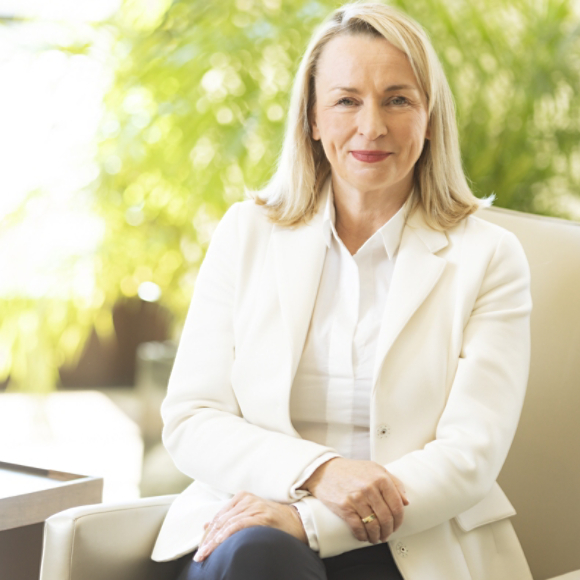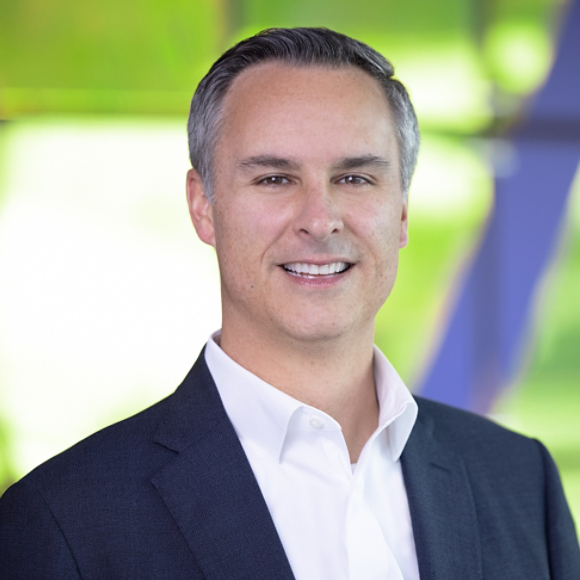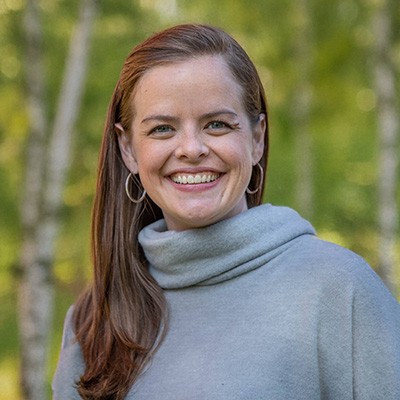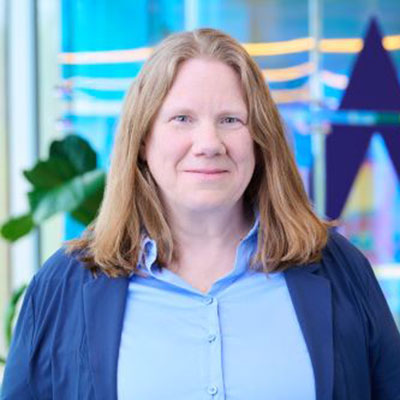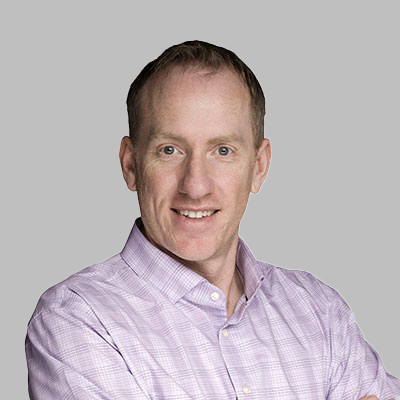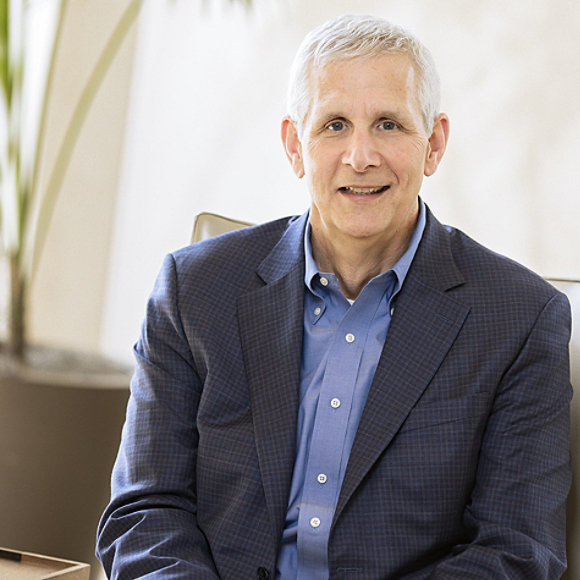August 19, 2025
Connecting the Dots: Unlocking Innovation with Systems Thinking
Season 5 Episode 5: How innovation, sustainability, technology and a purpose-aligned culture are all linked together.
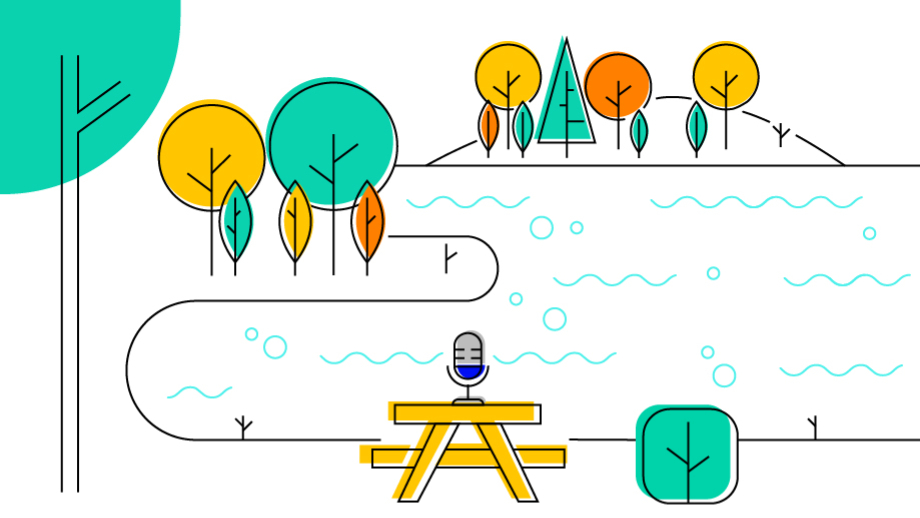
Break down those barriers and shake off that siloed thinking: sustainability, technology and innovation have never been more aligned. All it takes is a change in perspective.
Pioneering leaders around the world are now viewing sustainability not just as a requirement, but as an opportunity. With experienced guidance, cutting-edge initiatives are now thriving in a place where sustainable innovation and growth are tightly intertwined.
In this episode, we speak to Mauro J. Atalla, Senior Vice President and Chief Technology and Sustainability Officer at Trane Technologies, and Hannah Black, Sustainability Engagement Program Manager at Trane Technologies.
We will discuss the systems thinking that unlocks sustainable innovation, the next generation of inspiring climate tech and how culture empowers employees to embrace and engage in a development strategy when it’s tied to both personal and business growth.
-The business of tomorrow needs to be sustainable. But when you're starting out, the learning curve can be steep. However, something magical happens when you turn sustainability on its head, you stop looking at the mountain and all the barriers in front of you, and you see the pathways and the opportunities. What it takes is a shift in perspective. And many times that starts with a visionary leader.
- It is a culture that combined with mission that you know is, is around sustainability, gives the employee the opportunity to feel that they can make a difference, right? It is a culture where every, everyone that I speak to here feels like they have something they can do to make the environment better, our customers better, the company better.
- Putting sustainability at the center of the business is about more than just a pledge on the wall. It means creating an uplifting and supportive culture full of passionate people who know that their contributions are making a difference.
- You're listening to Healthy Spaces, the podcast where experts and disruptors explore how climate, technology and innovation are transforming the spaces where we live, work, learn, and play. I'm Scott Tew, Sustainability Leader at Trane Technologies.
- And I'm Dominique Silva, Marketing Leader here at Trane Technologies. And on Season Five of Healthy Spaces, we're bringing you a fresh batch of uplifting stories featuring inspiring people who are overcoming challenges to drive positive change across multiple industries. We'll explore how technology and AI can drive business growth and help the planet breathe just a little bit easier.
- Hey Dominique. So before we get started today, just a heads up, today's episode is a little bit different.
- Oh, Scott, I've already heard all about it, and I'm actually kind of jealous. They actually let you take this show outside?
- They did. They sure did.
- How is that even possible?
- This episode is one that our listeners might want to check out on our YouTube channel. I was down by the lake, Trane Technologies campus in Davidson, North Carolina. It's the perfect open sky location for a big picture thinking conversation.
- Aw, you're so lucky, Scott. And great weather too. Well let it be noted to the producers, totally on the record, I'll be waiting for my turn with the film crew.
- I'm sure they can make that happen. This interview was particularly special to me because of my guest, Mauro Atalla, who is the new Chief Technology and Sustainability Officer at Trane Technologies.
- And as you just said, so Mauro is a new addition to the Trane Technologies community. So, he only joined the company at the beginning of this year. So this interview is actually a great opportunity for all of us to get to know him.
- And you know, he's developed quite a unique perspective throughout his career on this intersection of all the topics we'll talk about sustainability, technology, and how people are engaged.
- Those are three heavy hitting topics. Should we get right into it?
- Yeah, let's do it. Welcome to Healthy Spaces. I'm Scott Tew, I lead sustainability for Trane Technologies, and today I'm excited to have this episode where we talk about career, we talk about sustainability, we talk about technology, and all the intersections of those things with my special guest Mauro, who's here with me. And if you are listening to us and you can't see where I'm sitting, you should, if you hear strange sounds, it'll be the birds overhead, maybe geese swimming by, as we sit outside on the Davidson, North Carolina campus for Trane Technologies. We also are recording this on a very warm summer day. We are in the middle of a heat wave like many other parts of the world. And that's something that Trane Technologies knows a lot about. So it's very appropriate that my guest Mauro joins me to talk about all things technology and sustainability. Welcome.
- Thank you very much, Scott. It's, it's nice to be outside.
- It is, but it's early.
- It's early, which is good. And it's humid, it reminds me a lot from Brazil, right? From
- That's right.
- you know, where I came from.
- Well, you just opened with something that I wanna ask you about. So Mauro, you recently joined the company. You're pretty new to the company, January of this year, and you come to us with a lot of background and perspectives, not just from your career, professional career, but also you're Brazilian. So can you help our listeners understand first your background, career wise, things that interest you on the career side, and then we'll switch over to the personal.
- All right, so career wise, I have a fairly, I guess, unusual career. I spent about 10, 12 years in academia, so that's what I was doing, you know, basic research, getting my Masters, my PhD here in the U.S. So, and then I spent another 10 years or so doing more applied technology development. So that's where I worked at a company that used to be called United Technologies, where I had the opportunity to work on everything related to buildings, from elevators, air conditioning, fire surveillance systems,
- So all the mechanical systems.
- All the mechanical systems in the building, but more from a technology development, think of that as advanced concepts,
- Right.
- Right. For, for those businesses and systems. And then I spent another 10 or so years in aerospace. So, I moved to the other side of the corporation and I had the opportunity to work on aerospace, which is really, really different. So I was in a part of the company where we developed systems for aircraft. Essentially almost everything that's inside an aircraft was part of that portfolio.
- And now you've got it all wrapped up into one big ball with Trane Technologies. You joined, you're responsible now for innovation for the company. You're responsible for engineering and technology. You're also responsible for sustainability.
- Yes.
- So tell me about the first six months or so with the company. What's your perspective on the company you've joined?
- Look, I mean, when, when you decide to make a change in career, like I did, right? One of the very important things that at least I was looking for is like cultural fit, Right? Because you need to be in an environment where you're able to realize the potential, where you can use the knowledge, experience that you have, and have a positive impact. So if, you know, getting to your question about the six months, it will exceed my expectations, right? It is-
- The culture?
- Yes, the culture, but also how important it is, you know, technology and product to what the company delivers to our customers. It is also about, like you said, part of my role is to be responsible for sustainability. It was also about how sustainability is embedded in the business, is not something that's on the side, it is how we, you know, run the business, it is how we deliver value to our customers. But, but all enabled by the culture. Right?
- Let's talk about the intersection, that intersection of technology and sustainability. I mean, you've got a, a you've got a career behind you. You've now joined a company that we talk a lot about that intersection. What's your view given your background as well as how it, how you think things are with Trane Technologies?
- So sustainability's a very broad topic.
- Yep.
- Right? And there is no-
- So is, so is technology, right?
- Exactly, and, and, and there are multiple intersections.
- Right.
- But there is no one solution, right? That's gonna address sustainability. So when you look at that problem, you need to think about the entire system. So you need to think about how you design the products, what you use to, you know, to manufacture the products and, and how you manufacture the products. It is how the products perform in the field. You need to look at all those things to be able to have a meaningful impact. The good thing about what I've seen the first six months is that we are looking at all these different factors. I haven't seen one that I say there is a gap here. I, and, and conversely, there are a lot of opportunities, right? It's not a solved challenge by a long shot, so there is a lot to be done still, and, and I'm excited. I mean, there's a lot that we can accomplish.
- A lot of our listeners, Mauro, probably have heard this whole concept that there's big opportunities with the systems thinking. I know that you are a, you're a, sort of a constant learner, and I know that you're a systems thinker. So what is the big deal about the systems thinking that listeners might not understand? You think?
- Well, I, I'll probably give you two examples. So one is in, in a certain type of building, there are several of those. You wanna have cooling certain parts of the building and you may need to have heating in other parts of the building. So what has been done traditionally is that you use a cooling solution, think about a, a, a hotel in the guest rooms and you use heating for the kitchen or the laundry.
- So they're both, they're both on at the same time.
- They're both on at the same time. They're both rejecting energy. Because you think about HVAC, it's all about thermo system. It's all about moving energy from one place to another. So you have the guest rooms where you're taking energy out of the room and, and, and pushing it outside the building. And you have the laundry where you're burning fossil fuel to generate heat. And that heat's also being dissipated somewhere. And if you think about that and you look at the whole building, why can't you take the heat that you are taking out of the guest room and use it-
- Pull it back into-
- Somewhere inside the building, right? So why waste energy? So you need to look at the entire application. So that's one example. The other one I would say, if you think about data centers or any industrial process where you need to either cool very much or right, you need to take the heat out of the data center in that example. You can use that in the community that may be near the data center. You can use that for something that's called district heating. You can take that heat, that warm water and use it for the community, right? That's next to it. Instead of just rejecting the heat to the-
- Just really stepping back and finding all of the opportunities.
- Exactly. So you need to understand what problem you're trying to solve, not just a specific thing that's ahead of you.
- Right.
- Because then you can, you're gonna be able to potentially create new solutions that are, were not obvious at the beginning, right? If you only look at that narrow scope.
- So Mauro, you're joining the company at a very special time. We're at the midpoint of the 2030 commitments. One of those commitments was something we call the Gigaton Challenge, which was essentially about reducing the emissions when our products are being used with our customers. We committed to reduce the emissions by a billion metric tons by 2030. We're making great progress, but you know, you've just come into the company, you've been spending a lot of time in our factories, spending a lot of time with our associates, spending a lot of time with our engineers. What's exciting to you about this Gigaton Challenge?
- It is interesting, right? Because I think first of all, by the way, you were here, you were instrumental to creating that challenge, right? Back in 2019. I believe back in the day, you can confirm if I'm wrong, but I believe back in the day, we didn't have this all roadmapped.
- No, not at all.
- Right? So it was a challenge. It was something that we didn't quite know how to get there. We, the company knew it would make a difference to the environment, to our customers. So it is grounded on what customers need and value. It's, it has a positive impact on the environment. It was far from something that we were certain that we could do.
- Correct.
- Now it is interesting because it's very simple, right? In terms of articulating, explaining what it is. But at the same time, it, it brings all different elements together because it brings the technology, right? We need to figure out how to make our product more efficient. It also motivates all the employees to think about different ways of doing things.
- Yep. So that's linked to innovation first.
- Exactly. I mean, it's a catalyst, right? And it's, I find it powerful because in its simplicity and its relevance. And you don't have to be explaining all the details and all. It's very, very simple and clear. And it continues to be a challenge. We're halfway through. There's a lot of work to be done still.
- Exactly. Okay. So Mauro, a lot of your day is spent at Trane Technologies focused on the built environment. 'Cause we do, we have so many solutions for the built environment, whether we're talking efficiency or cooling and comfort, a host of things. Can you, can you gimme your thoughts about a specific type of building that's on people's minds right now, that's data centers. It's on people's minds, because there's a lot of talk about AI and digitalization, how companies and individuals are using AI and the tools, but we also know that data centers come with a downside because they are highly energy intensive. What are your thoughts about better buildings and especially better data centers?
- I think buildings in general, right? I think we continue to operate using the thermodynamic cycle, right? That the physics haven't changed.
- Very technical term.
- Yes. Sorry. So it's about how you move energy from one space to another and how you use refrigerants to take that energy and move it around, right? And, and transfer that. And the physics are not gonna change, but how we go about doing that and moving that energy, we can continue to make that more and more efficient. So whether it's a traditional building, it's in how we choose what refrigerants we use, it's about what information do we use to control the equipment that's cooling or heating that building. So for example, an air conditioning in a building or a home, it knows about the temperatures, it knows about how fast fluid is moving around, it knows about pressures. But if we could also provide information about what is the weather gonna be like three hours, six hours from now, right? What are the electricity rates gonna be like three hours, six hours from now? That helps us make better decisions, right? For that building. And that leads to less energy use, which better for the environment, right?
- So it plays also into the design of those buildings as well as how they're operated, right?
- Exactly. Exactly. So you need to step back and look at the whole system, and taking even one step further back is like, what information's not there that I can bring from other places to help me do a better job?
- Can you gimme your thoughts about what's the concern with data centers and what are some of the ways to solve those concerns?
- So data centers are exciting in, in the sense that they push the boundaries of what the technology can do from an efficiency perspective. So, one way to think about data centers is you bring energy into that building, electricity,
- Right?
- you do a lot of calculations and all that energy came in essentially becomes heat, right?
- And, and the chips, like your home computer that has a fan, needs to be capped under a certain temperature. The same is true in data centers.
- Is that something we would call waste heat?
- It becomes waste heat, right? Because you wanna cool that, those chips, those racks. And as you move energy from inside the data hall to the outside, then you have waste heat, which is the, you know, we rejected energy, you know, outside. So it pushes the limits of what we can do today because these data centers are becoming more and more powerful,
- Right?
- And so they become more energy intensive.
- Meaning hotter.
- Meaning hotter, right? And you wanna make sure, number one, that back to the conversation about efficiency, sustainability, that every watt of energy that comes into the building is used for computing, not dissipated as heat. So if you look at the entire data center, you wanna make sure that you're as efficient as you can be. And cooling those racks is a type of system that needs energy to run,
- Right?
- You want them to be as efficient as possible, right? In moving that energy from the rack to outside the building. And we talked about systems before, it's one of those where you can step back and say, so what do you do with all that energy? Right? You can look for ways to repurpose that energy. You can try to run through what's called a district heating loop. So if there's a community nearby, you can use that warm temperature water to go heat that community.
- So we're rethinking this whole concept of waste, in terms of waste heat, and maybe it becomes something else that's not wasted.
- That is true. And a different way also to look at data centers and some of the trends in technology, as they become more powerful, they run hotter, the temperature of that water that comes back from the data hall, right? Is higher, the temperature is higher. And what we're finding is oftentimes that water temperature now is higher than the outdoor temperature. So then what you can do, it can do what's called, you know, free cooling. It essentially you run that water, right, through, you know, heat exchangers like you have outside your home, and fans. And you drop that water temperature that way using fans, which consume a lot less energy than compressors.
- So the loop, the loop becomes something that is more efficient and there's less waste.
- Exactly. I mean, we, we have done, worked very closely with our customers to look at their system and their needs and develop solutions that use free cooling, that save like 40% of the energy that are traditional systems that use only compressors would have used.
- Hearing you describe that Mauro I, I've been working with you for a while now, and one of the things that I've learned is that you, yourself are a constant learner, sort of encouraging all of us that work with you to stretch our thinking around how to solve certain things, and so I'll put that back on you now, what are you, what are you learning right now? What are you excited about learning?
- You're right. I like to learn different things and, and I've, I've been very lucky that in my career I've been able to touch many technical disciplines. Not just my, my formal mechanical engineering background, but a bunch of other things. What I'm more interested right now, it's around machine learning.
- Hmm.
- And understanding how robust is it, how mature is it?
- What's machine learning for our listeners who may have never heard that term?
- Think about AI. So machine learning is the underlying mathematics that allows you to learn from all the data that's available and do things what ChatGPT does today.
- So the machines themselves become smarter and part of the solution.
- Exactly. So going back a very long time, right, into the past. When I was doing my graduate study, I was using what was called neural networks machine learning, AI, which they don't even teach that today it's so basic, right? So I've been following that field and I believe that now given all the acceleration coming from the processors that enable much more sophisticated algorithms to be run. We are at a point now where there's a lot of knowledge that can made avail, be made available to folks. And how is that gonna change what we do? It's just something, regardless of my job today, but part of, also of my job, but just understanding how does that, how is that gonna change? What is that gonna enable? So that's one that I keep playing all the time with.
- You know, AI and data centers are just like, for some people they're way out there. And part of your job as a CTO, as a Chief Technology Officer, is to think about horizon. Like what's, what's emerging, what's on the horizon? What are, what are your thoughts today in an exciting year where there's many things going on. And on this hot day that we're, we're experiencing here, and some of our listeners are, what are your thoughts about things on the horizon that we should have our eyes on?
- I think, so speaking, we talked about how, how humid it is, how hot it is, right? So if you think about the energy that an air conditioning uses, a part of it is to dehumidify that air, that's in that space-
- Which makes the air more comfortable, right?
- Exactly. Right. And, and so you need to reduce the temperature, reduce the moisture content. So one of the areas that we need, we are looking and working on that's on the horizon, is how you remove moisture from the air before it comes into your building or before it goes into your cooling system, so that that cooling system now uses less energy to cool
- Sort of pretreated.
- Pretreated, exactly.
- Hmm.
- So how do you remove that moisture in an energy efficient way to do that? That's one area we're looking at. There's a lot of work going on in controls. So how are, how do we get smarter about controlling not only our equipment with information about what the weather's gonna be like or what the electricity cost is gonna be like, but also how do we coordinate how our system operates in conjunction with other systems that may be in that building, hotel, hospital, data centers?
- So connecting all the dots of the system
- So when one's going up, we maybe coming down, when we know there is energy flow coming from there, we can do something different. So just look at the entire picture of how do we control that system is another area where there is a lot of benefits still to be gained. Because if you think about it, about 30% of the energy that is after the meter, right? It's inside the, the, the built environment, the built space, about 30% of that is wasted because of, you know, the deficiency of the systems. So anything we can do to waste less, it's a huge benefit that also reduces the burden on the grid, or reduces the burden on the-
- It's like a long term, it's like a long term impact.
- Exactly. Exactly.
- Speaking of long term impacts, a lot of our viewers and listeners, Mauro, on this Healthy Spaces podcast, they have a personal value in sustainability. I think that sustainability means different things to different people, but for many it's very personal, the things that they care about. What's your, what's your view, what's your, what does sustainability personally mean to you?
- It's interesting, right? So I I I, I grew up in Brazil and I've lived in a bunch of different places. So I've been from probably the hottest place I've been was, was in Brazil where I was born in Belo Horizonte, and the coldest when I lived in Minneapolis. Right?
- Two extremes.
- Two extremes. Yeah, from 40 C to minus 40 C. But it is in, in my lifespan, it is visible how the environment has changed. Right? I remember growing up the, the winters in Sao Paulo, they were always foggy, always rainy. That doesn't exist anymore. How even the weather patterns have changed since I've, I've lived in the U.S. I have two children, one is now gonna be 23, you know, in a couple months, the other one's 21. They're gonna see probably a lot more change if we don't continue to work in this area. So for me, it's both the realization, what I've seen in terms of change, and if I just think about in forecasting, if nothing gets done, what this may lead to, right? Because the earth, the planet's a very complex system, we don't fully understand it. There is always a risk that we may go through some tipping point that accelerates processes that we may not fully understand. So whatever we can do to keep this in control, under control, the better for everybody.
- And Mauro, no matter where our listeners are right now, they all have some perspective on the culture they're in. It could be a, in a classroom, could be in a NGO, could be in a large organization. All of those have very distinct cultures. You mentioned earlier something about integrating sustainability. How important is culture to integrating it?
- It's probably the most important thing. So over my career, I've been part of companies that acquire many other companies. When it was the first time I realized how different cultures can be in companies.
- You get to see it there.
- You get to see it, and you get to see how bringing cultures together is hard.
- Yeah.
- There are no equations for that. There is no closed form solution. Right?
- You don't just send out a memo, do you?
- You can't. Right? That's not enough by a long shot. And it drives everything. It drives the behaviors, it drives the measurement systems, it drives how employees feel when they come to work and, and how productive and, and they feel and they are. So what I observed here at Trane Technologies is the culture here is very, very healthy in the sense that, and what I mean that is, it is very inclusive. So coming in here from the outside, I ask a bunch of, you know, dumb questions, but very inclusive, very open, and very supportive. And it is a culture that combined with mission that you know, is, is around sustainability, gives the employee the opportunity to feel that they can make a difference, right? It is a culture where every, everyone that I speak to here feels like they have something they can do to make the environment better, our customers better, the company better.
- They feel connected to something else.
- Absolutely. Right? And what I also see is that we're investing in it, you know, we're just completing the first cohort of managers that we nominated to go to a new program that we co-developed with the Harvard Business School. Right? On how you do sustainable, you know, business leadership.
- Right.
- Right? So how can you be a leader in this industry and think about sustainability, the customer, the business. So you invest in building that capability, and then ultimately, right, you have all the processes that we use to run the company that have sustainability built into it, but they're all like, it, it's, it's amazing how seamlessly integrated it is with the culture, right? It's not, you don't see people asking, so how is this aligned with that? It's all makes sense.
- Does this work with a growth mindset? Because some out there, some of our listeners may think that doesn't really work with a growth mindset. What is your view?
- Oh, it does. I mean, it's, it, I actually think that's necessary, right? For growth. If, if you have everyone feeling that, you know, they're engaged, it can make a difference. If we have the Gigaton Challenge and other challenge that we have that give everybody focus and purpose, and that challenge then is grounded on customer needs and, and the environmental impact on sustainability. These are all aligned. They all build on each other, so there is no trade off here.
- Mauro, thank you. It's been fantastic to have you on Healthy Spaces. I know that our listeners will agree that your perspective, long-term perspective, based on your background is really refreshing. So thank you.
- Thank you very much, Scott. It's been great to participate. It's great to be part of this new season where we now are not just media audio but we have video, we're gonna have diff, you know, different channels to disseminate information. And it is great that we did here. I don't think we could have picked a better place.
- Very nice.
- Thank you.
- Thank you.
- That was Mauro Atalla and it was such a delight to interview him. One of the things that Mauro spoke about was the importance of the work environment and culture where people uplift each other and feel empowered in what they do. It's the actions of many that make an impact, even if they're small actions, together. It's a huge impact on our planet and in our communities. And here to talk a little bit more about that is Hannah Black. Hannah is the Sustainability Engagement Program Manager at Trane Technologies.
- Hi, my name's Hannah Black and I'm based in Cincinnati, Ohio. I'm a part of Trane Technology Center for Energy Efficiency and Sustainability Team. And, in my role as a Sustainability Engagement Program Manager, I get to wear many hats related to sustainability from working with our comms team to make sure we're putting out sustainability reports with accurate data, with strategy transparency, as well as working across the businesses with leaders to help them understand how we're gonna get towards our 2030 sustainability commitments. But where I find the most reward and impact in my work is to develop our employees on sustainability. We have a group of, almost one thousand employees are part of our Sustainability Ambassador Network. And this past year I helped to champion a new steering committee of employees that are going to lead the strategy of the, the Sustainability Ambassador Network. And the purpose of this network is for employees that are really passionate about sustainability, to have a community that can not only help educate them on some of these more complicated sustainability topics and terminology, but also to give them the right tools and resources for them to be advocates in their community, with customers and with their colleagues on what our 2030 sustainability commitments are, and how they each can contribute to them. It has been fantastic to see the transformation of this group, and how having so many more minds coming together to develop a plan to support these employees has just blossomed so quickly. We got the results of our Earth Month challenge that, again, historically I led. Now we've seen almost a 65% increase in engagement and a huge growth in how many people participated this year. Thanks to, again, those 25 global employees that are steering this group and making sure the word's getting out there, that they, that any employee can get engaged and have an impact on our 2030 sustainability commitments.
- Thanks to Hannah, she's as wonderful as she sounded in this episode, and she's a great team member, so happy to have her on the team. And so that's a wrap on this episode, episode five of Healthy Spaces. Dominique, what are your thoughts?
- Well, Scott, that was an amazing interview. And not only because it was held in the open air, congrats on that again, but what I really liked was how the conversation proved the importance of systems thinking. So when it comes to some of the emerging challenges that we're facing today in the built environment, especially really complex environments like data centers, we just can't separate things into silos anymore. And a great leader is someone who is able to connect all of those dots together.
- Yeah, exactly. And Mauro also made that point of underlining how important employee engagement is. I mean, when we talk about the alignment of sustainability and business goals, the other key piece of this is engaging our people. The experiences and the perspectives of team members actually strengthen our ability to develop innovative solutions for these system problems and ultimately to drive growth.
- I couldn't have said it better myself, Scott. And you know what, I'd like to hear what our listeners out there think. So how do you or your coworkers participate in sustainability initiatives at your workplace? Leave us a comment, let us know.
- And that's it for this time. This has been The Healthy Spaces Podcast with me, Scott Tew and my co-host and friend Dominique Silva. If you want to know more about the topics covered today, you can find all the links in the show notes. We are back in two weeks with another episode, so be sure to like and subscribe so you don't miss out. Thanks for joining. We'll see you next time.
Featured in this Episode:
Hosts:
-
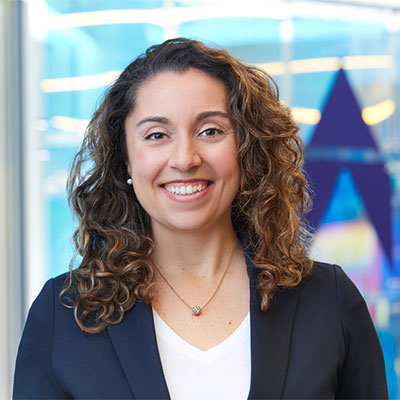
Marketing Leader EMEA, Trane Technologies
-
Global Head and VP, Sustainability Strategy, Trane Technologies
Guests:
-
Senior Vice President and Chief Technology and Sustainability Officer, Trane Technologies
-
Sustainability Engagement Program Manager, Trane Technologies
About Healthy Spaces
Healthy Spaces is a podcast by Trane Technologies where experts and disruptors explore how climate technology and innovation are transforming the spaces where we live, work, learn and play.
This season, hosts Dominique Silva and Scott Tew bring a fresh batch of uplifting stories, featuring inspiring people who are overcoming challenges to drive positive change across multiple industries. We’ll discover how technology and AI can drive business growth, and help the planet breathe a little bit easier.
Listen and subscribe to Healthy Spaces on your favorite podcast platforms.
How are you making an impact? What sustainable innovation do you think will change the world?
Topic Tags

 English
English
